Citroen JUMPER 2008.5 2.G Owner's Manual
Manufacturer: CITROEN, Model Year: 2008.5, Model line: JUMPER, Model: Citroen JUMPER 2008.5 2.GPages: 163, PDF Size: 2.57 MB
Page 101 of 163
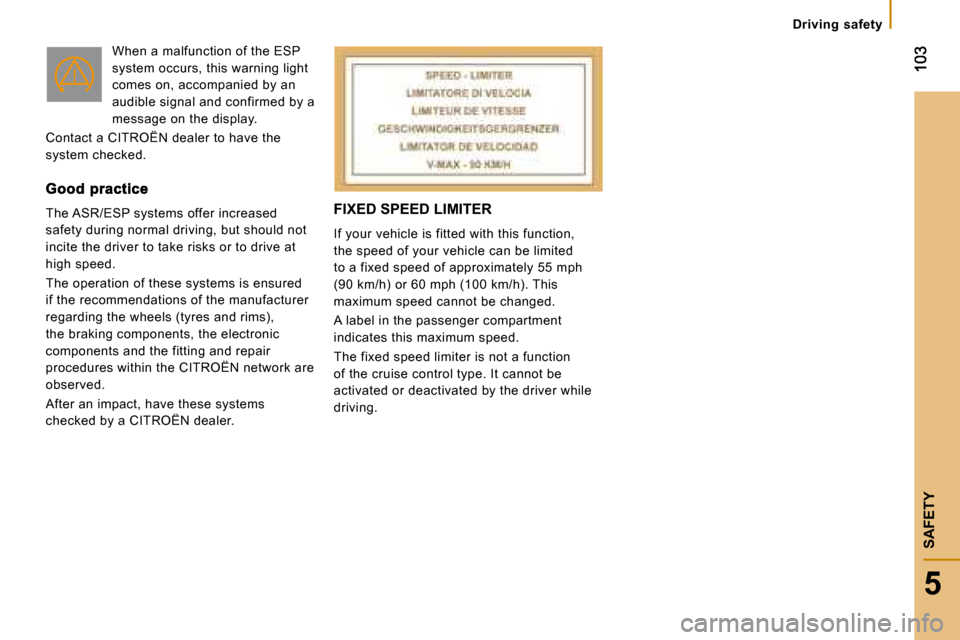
5
Driving safety
SAFETY
FIXED SPEED LIMITER
If your vehicle is fitted with this function,
the speed of your vehicle can be limited
to a fixed speed of approximately 55 mph
(90 km/h) or 60 mph (100 km/h). This
maximum speed cannot be changed.
A label in the passenger compartment
indicates this maximum speed.
The fixed speed limiter is not a function
of the cruise control type. It cannot be
activated or deactivated by the driver while
driving.
When a malfunction of the ESP
system occurs, this warning light
comes on, accompanied by an
audible signal and confirmed by a
message on the display.
Contact a CITROËN dealer to have the
system checked.
The ASR/ESP systems offer increased
safety during normal driving, but should not
incite the driver to take risks or to drive at
high speed.
The operation of these systems is ensured
if the recommendations of the manufacturer
regarding the wheels (tyres and rims),
the braking components, the electronic
components and the fitting and repair
procedures within the CITROËN network are
observed.
After an impact, have these systems
checked by a CITROËN dealer.
Page 102 of 163
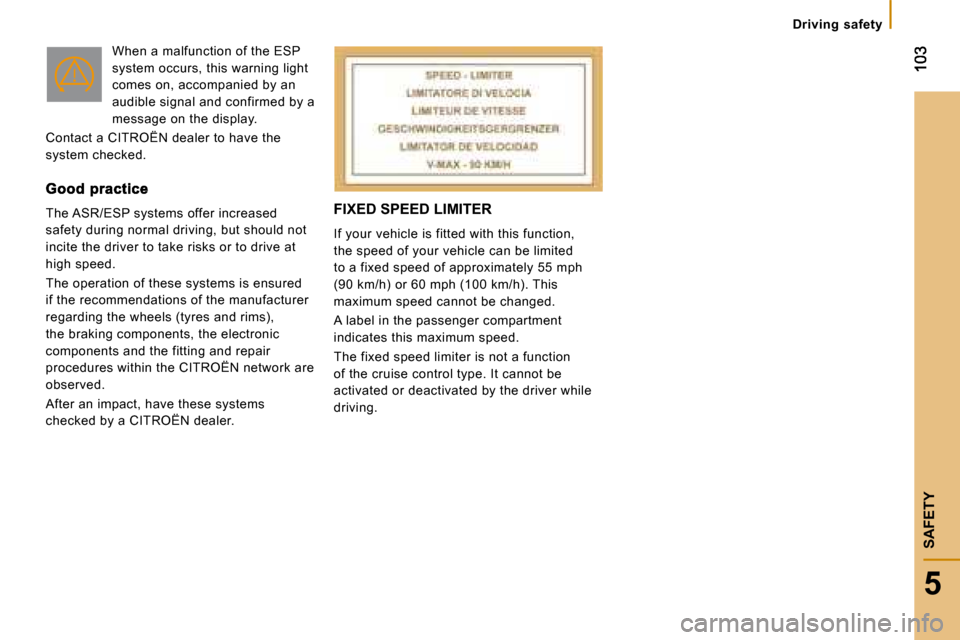
5
Driving safety
SAFETY
FIXED SPEED LIMITER
If your vehicle is fitted with this function,
the speed of your vehicle can be limited
to a fixed speed of approximately 55 mph
(90 km/h) or 60 mph (100 km/h). This
maximum speed cannot be changed.
A label in the passenger compartment
indicates this maximum speed.
The fixed speed limiter is not a function
of the cruise control type. It cannot be
activated or deactivated by the driver while
driving.
When a malfunction of the ESP
system occurs, this warning light
comes on, accompanied by an
audible signal and confirmed by a
message on the display.
Contact a CITROËN dealer to have the
system checked.
The ASR/ESP systems offer increased
safety during normal driving, but should not
incite the driver to take risks or to drive at
high speed.
The operation of these systems is ensured
if the recommendations of the manufacturer
regarding the wheels (tyres and rims),
the braking components, the electronic
components and the fitting and repair
procedures within the CITROËN network are
observed.
After an impact, have these systems
checked by a CITROËN dealer.
Page 103 of 163
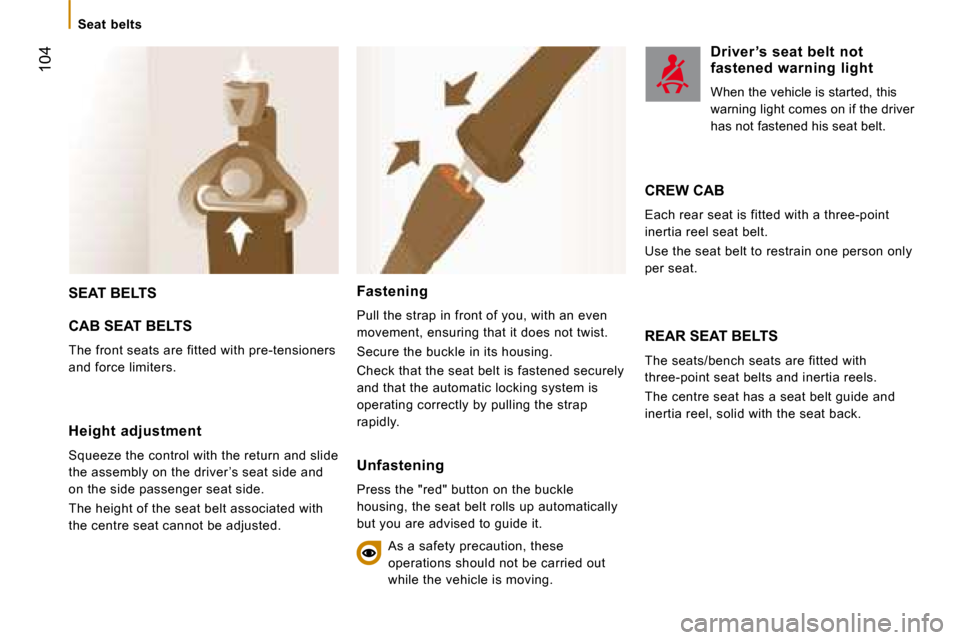
104
Seat belts
SEAT BELTS
CAB SEAT BELTS
The front seats are fitted with pre-tensioners
and force limiters. REAR SEAT BELTS
The seats/bench seats are fitted with
three-point seat belts and inertia reels.
The centre seat has a seat belt guide and
inertia reel, solid with the seat back.
Height adjustment
Squeeze the control with the return and slide
the assembly on the driver ’s seat side and
on the side passenger seat side.
The height of the seat belt associated with
the centre seat cannot be adjusted.
Fastening
Pull the strap in front of you, with an even
movement, ensuring that it does not twist.
Secure the buckle in its housing.
Check that the seat belt is fastened securely
and that the automatic locking system is
operating correctly by pulling the strap
rapidly.
Unfastening
Press the "red" button on the buckle
housing, the seat belt rolls up automatically
but you are advised to guide it. As a safety precaution, these
operations should not be carried out
while the vehicle is moving.
Driver ’s seat belt not fastened warning light
When the vehicle is started, this
warning light comes on if the driver
has not fastened his seat belt.
CREW CAB
Each rear seat is fitted with a three-point
inertia reel seat belt.
Use the seat belt to restrain one person only
per seat.
Page 104 of 163
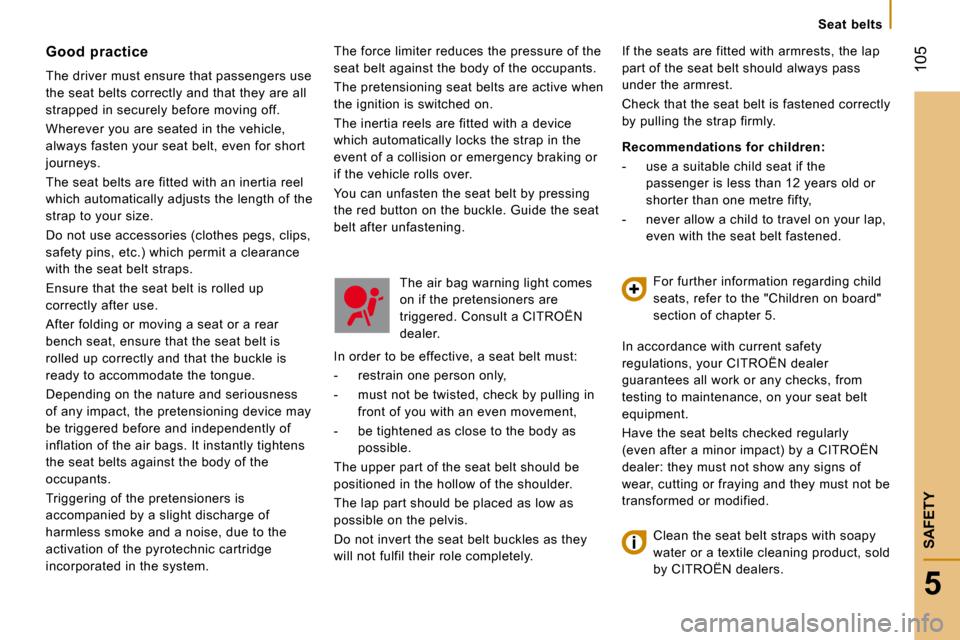
105
5
SAFETY
Seat belts
The force limiter reduces the pressure of the
seat belt against the body of the occupants.
The pretensioning seat belts are active when
the ignition is switched on.
The inertia reels are fitted with a device
which automatically locks the strap in the
event of a collision or emergency braking or
if the vehicle rolls over.
You can unfasten the seat belt by pressing
the red button on the buckle. Guide the seat
belt after unfastening. Good practice
The driver must ensure that passengers use
the seat belts correctly and that they are all
strapped in securely before moving off.
Wherever you are seated in the vehicle,
always fasten your seat belt, even for short
journeys.
The seat belts are fitted with an inertia reel
which automatically adjusts the length of the
strap to your size.
Do not use accessories (clothes pegs, clips,
safety pins, etc.) which permit a clearance
with the seat belt straps.
Ensure that the seat belt is rolled up
correctly after use.
After folding or moving a seat or a rear
bench seat, ensure that the seat belt is
rolled up correctly and that the buckle is
ready to accommodate the tongue.
Depending on the nature and seriousness
of any impact, the pretensioning device may
be triggered before and independently of
inflation of the air bags. It instantly tightens
the seat belts against the body of the
occupants.
Triggering of the pretensioners is
accompanied by a slight discharge of
harmless smoke and a noise, due to the
activation of the pyrotechnic cartridge
incorporated in the system. The air bag warning light comes
on if the pretensioners are
triggered. Consult a CITROËN
dealer.
In order to be effective, a seat belt must:
- restrain one person only,
- must not be twisted, check by pulling in front of you with an even movement,
- be tightened as close to the body as possible.
The upper part of the seat belt should be
positioned in the hollow of the shoulder.
The lap part should be placed as low as
possible on the pelvis.
Do not invert the seat belt buckles as they
will not fulfil their role completely. If the seats are fitted with armrests, the lap
part of the seat belt should always pass
under the armrest.
Check that the seat belt is fastened correctly
by pulling the strap firmly.
Recommendations for children:
- use a suitable child seat if the
passenger is less than 12 years old or
shorter than one metre fifty,
- never allow a child to travel on your lap, even with the seat belt fastened.
For further information regarding child
seats, refer to the "Children on board"
section of chapter 5.
In accordance with current safety
regulations, your CITROËN dealer
guarantees all work or any checks, from
testing to maintenance, on your seat belt
equipment.
Have the seat belts checked regularly
(even after a minor impact) by a CITROËN
dealer: they must not show any signs of
wear, cutting or fraying and they must not be
transformed or modified.
Clean the seat belt straps with soapy
water or a textile cleaning product, sold
by CITROËN dealers.
Page 105 of 163
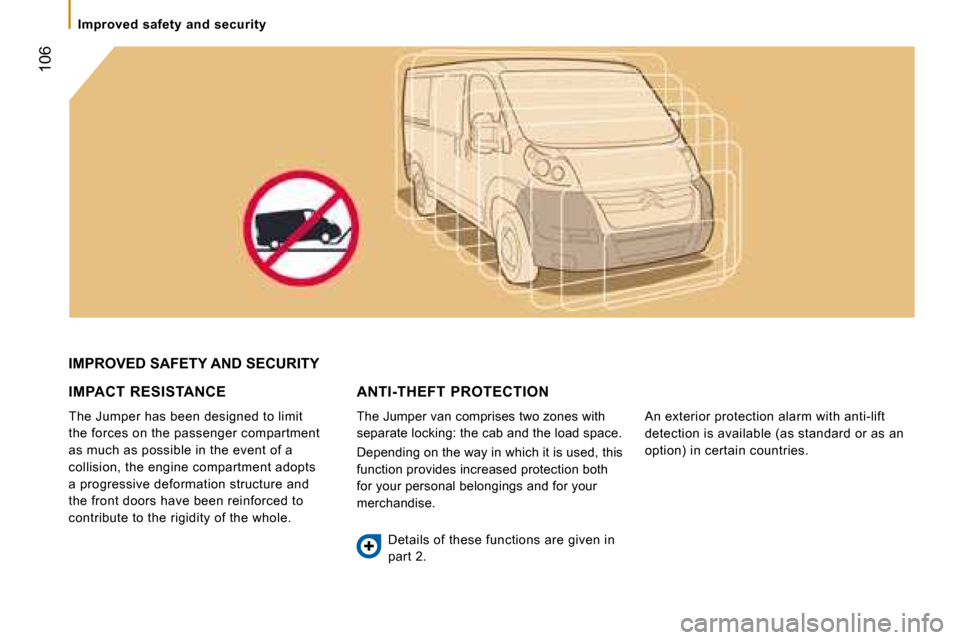
106
Improved safety and security
IMPROVED SAFETY AND SECURITY
IMPACT RESISTANCE
The Jumper has been designed to limit
the forces on the passenger compartment
as much as possible in the event of a
collision, the engine compartment adopts
a progressive deformation structure and
the front doors have been reinforced to
contribute to the rigidity of the whole.
ANTI-THEFT PROTECTION
The Jumper van comprises two zones with
separate locking: the cab and the load space.
Depending on the way in which it is used, this
function provides increased protection both
for your personal belongings and for your
merchandise.Details of these functions are given in
part 2. An exterior protection alarm with anti-lift
detection is available (as standard or as an
option) in certain countries.
Page 106 of 163
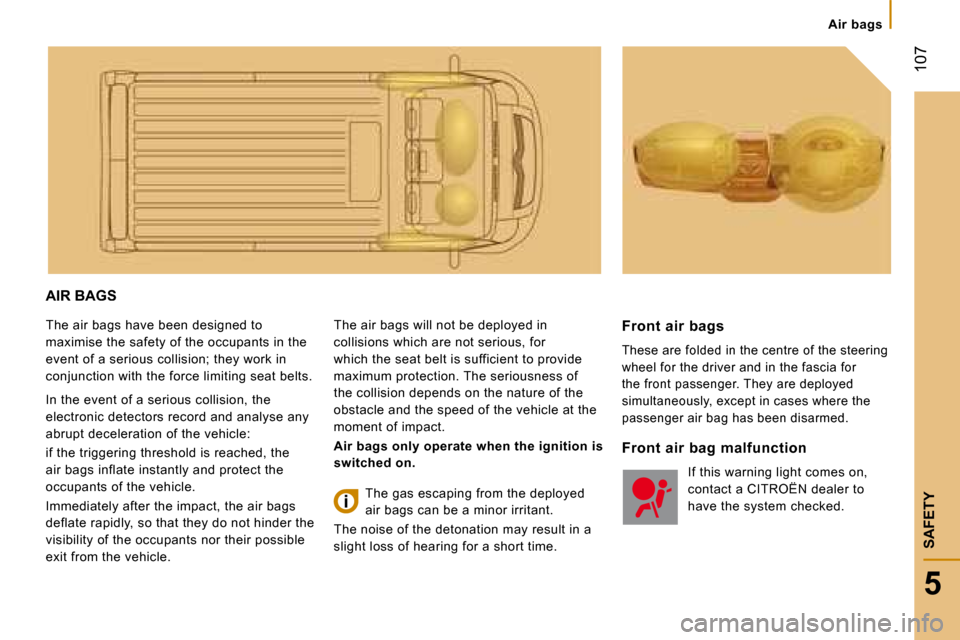
107
5
SAFETY
Air bags
AIR BAGS
The air bags have been designed to
maximise the safety of the occupants in the
event of a serious collision; they work in
conjunction with the force limiting seat belts.
In the event of a serious collision, the
electronic detectors record and analyse any
abrupt deceleration of the vehicle:
if the triggering threshold is reached, the
air bags inflate instantly and protect the
occupants of the vehicle.
Immediately after the impact, the air bags
deflate rapidly, so that they do not hinder the
visibility of the occupants nor their possible
exit from the vehicle. The air bags will not be deployed in
collisions which are not serious, for
which the seat belt is sufficient to provide
maximum protection. The seriousness of
the collision depends on the nature of the
obstacle and the speed of the vehicle at the
moment of impact.
Air bags only operate when the ignition is
switched on. Front air bags
These are folded in the centre of the steering
wheel for the driver and in the fascia for
the front passenger. They are deployed
simultaneously, except in cases where the
passenger air bag has been disarmed.
The gas escaping from the deployed
air bags can be a minor irritant.
The noise of the detonation may result in a
slight loss of hearing for a short time.
Front air bag malfunction
If this warning light comes on,
contact a CITROËN dealer to
have the system checked.
Page 107 of 163
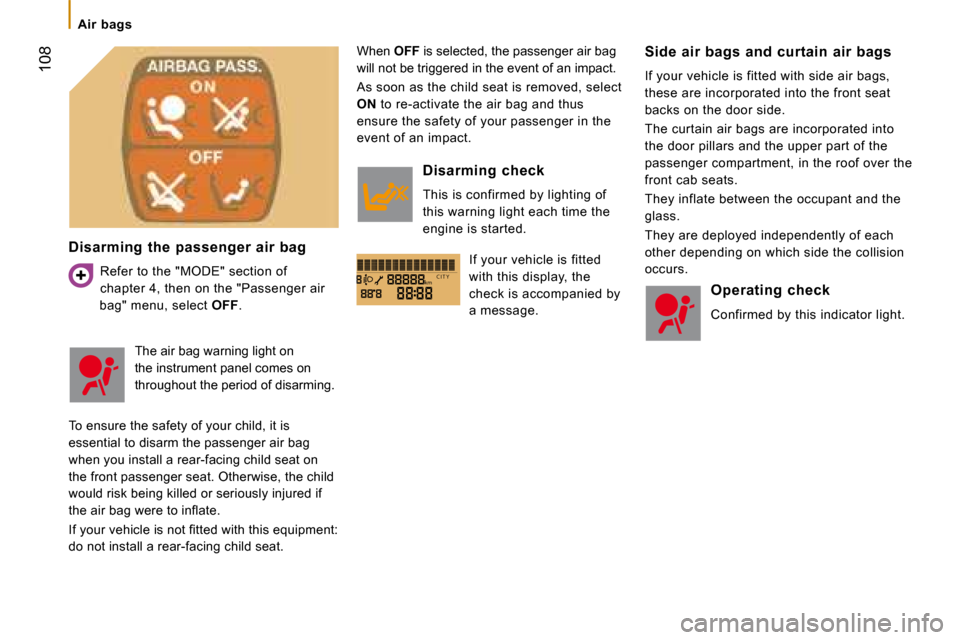
kmC I T Y
108
Air bags
Disarming the passenger air bag
Refer to the "MODE" section of
chapter 4, then on the "Passenger air
bag" menu, select OFF . When
OFF is selected, the passenger air bag
will not be triggered in the event of an impact.
As soon as the child seat is removed, select
ON to re-activate the air bag and thus
ensure the safety of your passenger in the
event of an impact.
Side air bags and curtain air bags
If your vehicle is fitted with side air bags,
these are incorporated into the front seat
backs on the door side.
The curtain air bags are incorporated into
the door pillars and the upper part of the
passenger compartment, in the roof over the
front cab seats.
They inflate between the occupant and the
glass.
They are deployed independently of each
other depending on which side the collision
occurs.
The air bag warning light on
the instrument panel comes on
throughout the period of disarming.
To ensure the safety of your child, it is
essential to disarm the passenger air bag
when you install a rear-facing child seat on
the front passenger seat. Otherwise, the child
would risk being killed or seriously injured if
�t�h�e� �a�i�r� �b�a�g� �w�e�r�e� �t�o� �i�n�fl� �a�t�e�.�
� �I�f� �y�o�u�r� �v�e�h�i�c�l�e� �i�s� �n�o�t� �fi� �t�t�e�d� �w�i�t�h� �t�h�i�s� �e�q�u�i�p�m�e�n�t�: �
do not install a rear-facing child seat.
Disarming check
This is confirmed by lighting of
this warning light each time the
engine is started.
If your vehicle is fitted
with this display, the
check is accompanied by
a message.
Operating check
Confirmed by this indicator light.
Page 108 of 163

109
5
SAFETY
Air bags
Good practice
If your vehicle is fitted with front, side
and curtain air bags, in order for these to
be fully effective, observe the following
safety rules:
Wear a correctly adjusted seat belt.
Sit in a normal upright position.
Do not leave anything between the
occupants and the air bags (child, animal,
object...).
This could hamper the operation of the air
bags or injure the occupants.
All work on the air bag systems is strictly
prohibited unless it is carried out by qualified
personnel of the CITROËN network.
After an accident or if the vehicle has been
stolen or broken into, have the air bag
systems checked. Do not drive holding the steering wheel
by its spokes or resting your hands on the
centre part of the wheel.
Passengers must not place their feet on the
fascia.
Smoke as little as possible; deployment of
the air bags can cause burns or the risk of
injury from a cigarette or pipe.
Never remove or pierce the steering wheel
or hit it violently.
Side air bags
Only put approved covers on the front seats.
Consult a CITROËN dealer.
Do not fix or glue anything to the front seat
backs. This could cause injury to the chest
or arms when the side air bag is deployed.
Do not sit with the upper part of the body
any nearer to the door than necessary.
Curtain air bags
Do not fix or glue anything to the pillars or
the roof. This could cause injury to the head
when the curtain air bag is deployed.
Do not remove the bolts from the grab
handles installed on the roof, they play a
part in securing the curtain air bags.
Page 109 of 163
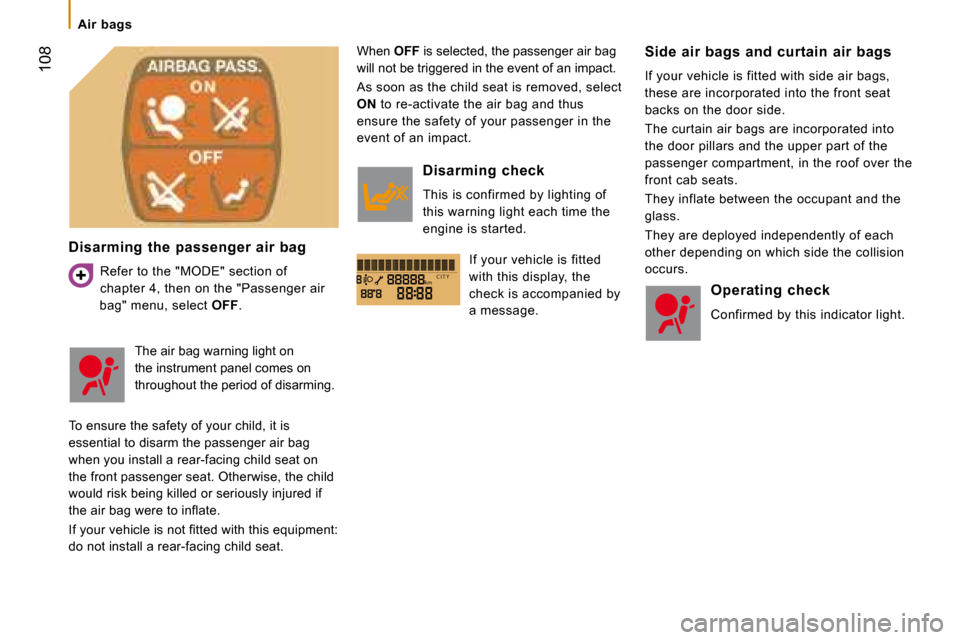
kmC I T Y
108
Air bags
Disarming the passenger air bag
Refer to the "MODE" section of
chapter 4, then on the "Passenger air
bag" menu, select OFF . When
OFF is selected, the passenger air bag
will not be triggered in the event of an impact.
As soon as the child seat is removed, select
ON to re-activate the air bag and thus
ensure the safety of your passenger in the
event of an impact.
Side air bags and curtain air bags
If your vehicle is fitted with side air bags,
these are incorporated into the front seat
backs on the door side.
The curtain air bags are incorporated into
the door pillars and the upper part of the
passenger compartment, in the roof over the
front cab seats.
They inflate between the occupant and the
glass.
They are deployed independently of each
other depending on which side the collision
occurs.
The air bag warning light on
the instrument panel comes on
throughout the period of disarming.
To ensure the safety of your child, it is
essential to disarm the passenger air bag
when you install a rear-facing child seat on
the front passenger seat. Otherwise, the child
would risk being killed or seriously injured if
�t�h�e� �a�i�r� �b�a�g� �w�e�r�e� �t�o� �i�n�fl� �a�t�e�.�
� �I�f� �y�o�u�r� �v�e�h�i�c�l�e� �i�s� �n�o�t� �fi� �t�t�e�d� �w�i�t�h� �t�h�i�s� �e�q�u�i�p�m�e�n�t�: �
do not install a rear-facing child seat.
Disarming check
This is confirmed by lighting of
this warning light each time the
engine is started.
If your vehicle is fitted
with this display, the
check is accompanied by
a message.
Operating check
Confirmed by this indicator light.
Page 110 of 163

109
5
SAFETY
Air bags
Good practice
If your vehicle is fitted with front, side
and curtain air bags, in order for these to
be fully effective, observe the following
safety rules:
Wear a correctly adjusted seat belt.
Sit in a normal upright position.
Do not leave anything between the
occupants and the air bags (child, animal,
object...).
This could hamper the operation of the air
bags or injure the occupants.
All work on the air bag systems is strictly
prohibited unless it is carried out by qualified
personnel of the CITROËN network.
After an accident or if the vehicle has been
stolen or broken into, have the air bag
systems checked. Do not drive holding the steering wheel
by its spokes or resting your hands on the
centre part of the wheel.
Passengers must not place their feet on the
fascia.
Smoke as little as possible; deployment of
the air bags can cause burns or the risk of
injury from a cigarette or pipe.
Never remove or pierce the steering wheel
or hit it violently.
Side air bags
Only put approved covers on the front seats.
Consult a CITROËN dealer.
Do not fix or glue anything to the front seat
backs. This could cause injury to the chest
or arms when the side air bag is deployed.
Do not sit with the upper part of the body
any nearer to the door than necessary.
Curtain air bags
Do not fix or glue anything to the pillars or
the roof. This could cause injury to the head
when the curtain air bag is deployed.
Do not remove the bolts from the grab
handles installed on the roof, they play a
part in securing the curtain air bags.